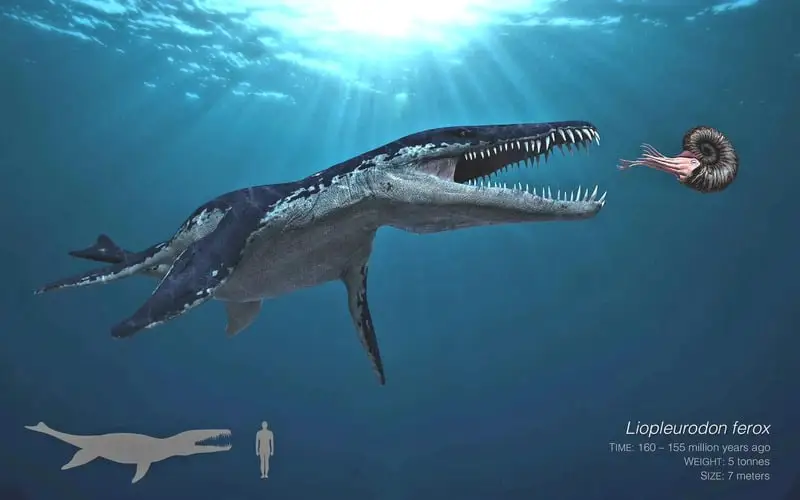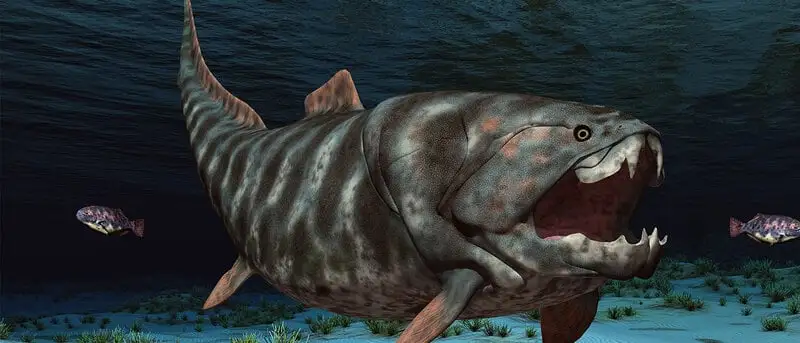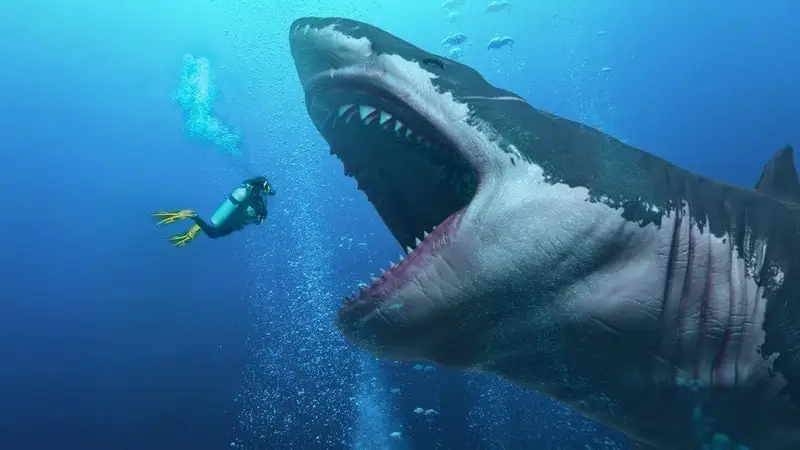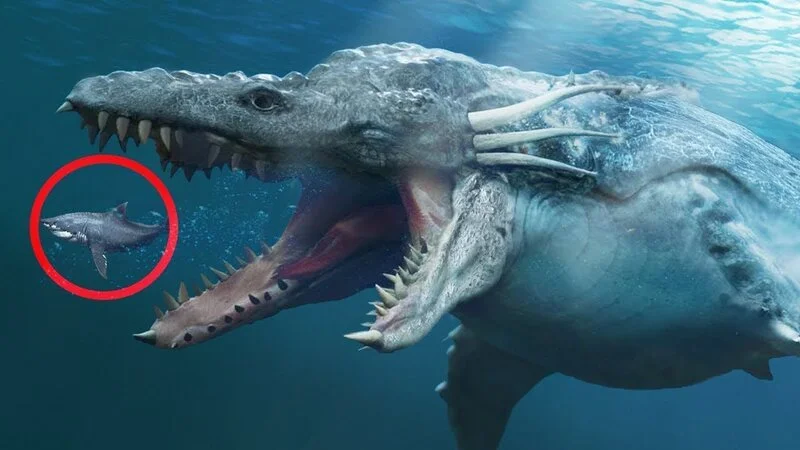The oceans have always been home to some of the most terrifying creatures on Earth.
From monstrous reptiles to giant sharks, these ancient animals once ruled the seas for millions of years before their eventual extinction.
If you think the ocean is frightening today, consider yourself fortunate not to have lived millions of years ago when these formidable creatures roamed the waters.
Prepare to be amazed and slightly unnerved as we take you on a journey through time to meet these ancient sea monsters that would make anyone think twice before venturing for a swim.
Here, we will introduce you to 10 of the scariest prehistoric sea creatures and delve into their dangerous nature.
10. Pliosaurus

Pliosaurus, a short-necked plesiosaur, inhabited the Earth during the Jurassic period, approximately 150 million years ago.
It had a massive head with powerful jaws and teeth that could crush bones and shells.
It was a true marine predator.
This prehistoric giant ranked among the largest of its time, measuring up to an impressive 15 meters (49 feet) in length and weighing around 45 tons.
Pliosaurus had a diverse diet, preying on fish, squid, and other marine reptiles like ichthyosaurs and plesiosaurs.
With its powerful four flippers, Pliosaurus swiftly navigated through water, showcasing remarkable agility for a creature of its size.
It was even capable of launching itself out of the water, making it an adept predator not only in aquatic environments but also on land.
9. Tylosaurus

Tylosaurus was a huge mosasaur that lived in the Cretaceous period, about 85 million years ago.
It was one of the largest mosasaurs ever, measuring over 13 meters (45 feet) long.
It had a long, slender body with four flippers and a tail fin. It also had a long snout with nostrils at the end, which helped it sense prey in the water.
Tylosaurus was an apex predator that fed on fish, sharks, turtles, pterosaurs, and even other mosasaurs.
With rows of sharp teeth and a powerful bite, it was a deadly hunter in its aquatic domain.
Additionally, Tylosaurus utilized its strong tail for swift propulsion, allowing it to reach high speeds while pursuing prey.
8. Thalassomedon

Thalassomedon was a long-necked plesiosaur that lived in the Cretaceous period, about 95 million years ago.
It had a small head with needle-like teeth and a neck that was longer than its body.
It could reach up to 12 meters (39 feet) in length and weigh up to 20 tons.
Thalassomedon used its long neck to catch fish and squid near the surface of the water.
It may have also used its neck to avoid predators by hiding it among seaweed or coral.
Intriguingly, Thalassomedon was a filter-feeder, employing its extended neck to reach down into the water and scoop up small marine organisms such as fish, squid, and crustaceans.
With its four flippers, it adeptly navigated through the water, displaying remarkable agility and control.
Furthermore, Thalassomedon likely employed its lengthy neck as a strategic defense mechanism, concealing it among seaweed or coral to evade potential predators.
7. Helicoprion

Helicoprion was a bizarre shark-like fish that lived in the Permian and Triassic periods, about 290 to 250 million years ago.
Its most distinctive trait was a peculiar spiral of teeth that grew inward from its lower jaw.
The teeth were arranged like a circular saw and could slice through flesh and bone.
The teeth arrangement in its lower jaw allowed Helicoprion to efficiently capture and process its prey.
This scary creature could attain a length of up to 4 meters (13 feet) and primarily fed on fish, squid, and other soft-bodied animals.
6. Kronosaurus

Kronosaurus was another short-necked plesiosaur that lived in the Cretaceous period, about 125 million years ago.
It had a large head with massive jaws and teeth that could reach up to 30 centimeters (12 inches) long. It was one of the largest marine reptiles ever, growing up to 10 meters (33 feet) long and weighing up to 11 tons.
Feeding on a diverse diet, Kronosaurus hunted fish, turtles, ammonites, and other marine reptiles, demonstrating its status as a fearsome hunter of the ancient seas. The creature’s two pairs of flippers endowed it with exceptional swimming capabilities, enabling it to navigate against powerful currents while chasing its prey.
5. Shastasaurus

Shastasaurus was an ichthyosaur that lived in the Triassic period, about 235 million years ago.
It was the largest marine reptile ever known, reaching up to 21 meters (69 feet) long and weighing up to 75 tons.
It had a streamlined body with a dorsal fin and a tail fin. It also had a very small head with tiny teeth and a long snout.
Shastasaurus was a suction-feeder that used its mouth to create a vacuum and suck in small animals like fish, squid, and crustaceans and even plankton.
It could also use its tail fin to propel itself through the water at high speeds.
4. Liopleurodon

Liopleurodon was another short-necked plesiosaur that lived in the Jurassic period, about 160 million years ago. It had a huge head with enormous jaws and teeth that could measure up to 30 centimeters (12 inches) long. It was one of the most powerful marine predators ever, reaching up to 7 meters (23 feet) long and weighing up to 3 tons. Liopleurodon ambushed its prey by hiding behind rocks or seaweed and then lunging at them with great speed and force.
3. Dunkleosteus

Dunkleosteus was a type of placoderm fish that lived in the Devonian period, about 360 million years ago.
It possessed a thick skull composed of bony plates, protecting its brain and eyes. Its jaws featured sharp edges akin to scissors, capable of slicing through flesh and bone effortlessly. This ancient creature could reach lengths of up to 10 meters (33 feet) and weigh around 4 tons.
As a voracious predator, it preyed on fish, sharks, and even its kind. Its powerful bite could penetrate through anything, making it an apex predator of its time. Additionally, Dunkleosteus possessed the remarkable ability to open its mouth rapidly, creating a powerful suction to draw in its prey.
2. Jaekelopterus rhenaniae

Jaekelopterus rhenaniae was a type of eurypterid, or sea scorpion, that lived in the Devonian period, about 390 million years ago.
It was the largest arthropod ever discovered, measuring up to 2.5 meters (8 feet) long.
It had a segmented body with eight legs, two large claws, and a long tail with a venomous sting.
Jaekelopterus rhenaniae hunted fish, amphibians, and other sea scorpions in freshwater and brackish environments.
Jaekelopterus rhenaniae was a formidable predator that hunted fish, amphibians, and other eurypterids (sea scorpions) in freshwater and brackish environments. It could also walk on land and breathe air using its gills.
The discovery of Jaekelopterus rhenaniae offers a captivating glimpse into the ancient world, unveiling the astonishing diversity of life that flourished millions of years ago.
1. Megalodon

Megalodon, the largest shark to have ever existed, remains an iconic and awe-inspiring creature of the past. Flourishing from the Early Miocene to the Pliocene, approximately 23 to 3.6 million years ago, this mighty predator was a close relative of the great white shark, but much bigger and stronger.
Measuring an astonishing 18 meters (59 feet) in length and weighing up to 100 tons, Megalodon commanded the oceans with unparalleled might.
It had a massive mouth with rows of serrated teeth that could reach up to 18 centimeters (7 inches) long.
It had a bite force of over 180,000 newtons (40,000 pounds), which is more than 10 times that of the great white shark.
Feeding on a diet of whales, dolphins, seals, and other sizable marine animals, Megalodon reigned as an apex predator of its time. Its ferocious appetite and astonishing size make it a captivating subject of study and speculation among scientists and enthusiasts.
Swimming at speeds of up to 20 kilometers per hour, and wielding a bite force of up to 182,000 newtons, Megalodon’s supremacy in the ancient seas is a testament to its enduring allure and significance in the annals of natural history.
These are just some of the scariest prehistoric sea creatures that ever existed. They may be gone now, but their fossils and legends remain to fascinate and terrify us.

